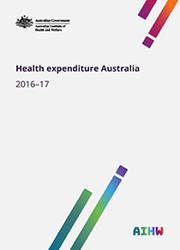Summary
Australia spent nearly $181 billion on health in 2016–17—this is more than $7,400 per person and 10% of overall economic activity. This represents higher growth in spending than in recent years. The real growth (adjusted for inflation) in health spending of 4.7% in 2016–17 was 1.6 percentage points higher than the average over the past 5 years (3.1%) and higher than the average over the decade for the first time since 2011–12.
Governments driving growth
More than two-thirds (69%) of health spending is funded by the Australian Government and state and territory governments ($75 billion and $50 billion, respectively) and governments were the main drivers of the recent growth in spending. Total government spending on health grew by 6.8% in real terms in 2016–17 to $124 billion, well above the average growth rate for the previous 5 years of 2.6%.
Tax revenue is the main source of government income used to fund public services, including health care. Due to the relatively rapid growth in government spending, the ratio of government health expenditure to tax revenue increased in 2016–17 following a period of relative stability (rising by 0.8 percentage points to 27.1%).
Real growth in health expenditure over the decade to 2016–17 was similar for the Australian Government and state and territory governments (4.5% and 4.6%, respectively), though average growth in the last 5 years was greater for states and territories (3.1% compared with 2.4%).
In contrast, in 2016–17, non-government sources recorded the lowest growth rate in health spending in the decade since 2006–07—0.2% compared with the decade average of 4.8%. Around $30 billion of this spending came from individuals.
Balance of public hospital funding shifting
In 2016–17, $69 billion was spent on hospitals—a real increase of $2 billion from the previous year.
Funding of public hospitals has shifted between governments in recent years. Australian Government expenditure on public hospitals rose 6.2% in real terms to nearly $22 billion, whereas state and territory government funding for public hospitals increased 0.1% in real terms from the previous year, to $27 billion.
Because of this shift, the share of public hospital funding contributed by the state and territory governments fell from 52.4% to 51.0%, with the Australian Government share increasing from 39.3% to 40.6% between 2015–16 and 2016–17.
Spending on new treatment for hepatitis C
Around $1.7 billion was spent on new treatments to treat hepatitis C in 2016–17. This contributed to an overall increase in Australian Government spending on benefit-paid pharmaceuticals of $1.3 billion in real terms.
Impact of private health insurance changes
Since the introduction of income testing of the private health insurance premium rebate in July 2012, the rebate amount paid by the Australian Government has not changed in real terms from 2011–12 (around $6 billion). This contributed to growth in net health expenditure by private health insurance providers of 4.8%, compared with average growth of 5.8% over the decade.
Preface: Acknowledgments; Abbreviations; Symbols; Summary
1 Introduction
- What is health expenditure?
- The structure of the health sector and its flow of funds
- Structure of this report
2 Health expenditure
- Health expenditure and the GDP
- Government health expenditure and tax revenue
- Health expenditure per person
- Recurrent health expenditure
3 Sources of funds
- Broad trends
- Australian Government expenditure
- State and territory expenditure
- Nongovernment expenditure
Appendix A: National health expenditure matrixes
Appendix B: State and territory health expenditure matrixes
Appendix C: Data sources and methods
Appendix D: Data quality statement for AIHW health expenditure data—2016–17
End matter: Glossary; References; List of tables; List of figures; List of boxes; Related publications



